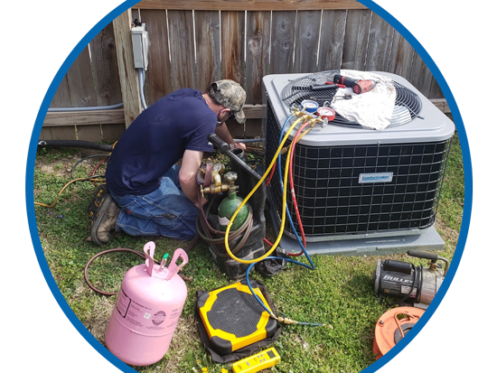The outdoor unit of your air conditioner has a huge amount of wiring and a part that plays a very important role in your AC system. This part is known as the AC capacitor.
Among all of the replaceable parts of the AC unit, the capacitor is replaced most often. This is due to the fact that it has complete control of your HVAC system and whether it runs or not. So when the capacitor fails, then your AC will be working twice as hard, which will raise your energy consumption.
In order to understand the AC capacitor completely, we will explain what the capacitor does, why it is necessary, and how it can be replaced.
What the Air Conditioner Capacitor Does
The air conditioner capacitor supplies the motors of your air conditioner with the necessary power to perform as they should so that the conditioning process can begin and get your home cooled. As soon as the air conditioner is putting out cool air, its capacitor decreases the amount it outputs while maintaining a power supply up until a cycle ends.
The air conditioner capacitor is measured by the number of microfarads and the voltage. The microfarads determine the capacitor’s maximum current. The voltage displays the amount of current that is flowing within the AC capacitor.
When there is a high amount of capacitor voltage, then the current will flow faster throughout. The AC capacitor’s microfarads can be as high as 80 microfarads.
Although an AC capacitor may have similar qualities as a battery, it should not be confused for one because it’s connected directly to the AC unit. This makes it difficult to just replace it when you feel like it.
This is why you should contact Level 9 Heating, Cooling, and Plumbing to change it out. Plus, you will be a lot safer and less likely to sustain an electrical shock when you attempt to change out the AC capacitor yourself.
Is The AC Capacitor a Necessary Part?
Regardless of the air conditioner being attached to the electrical system of the home, a higher amount of power is required if you want it to be effective. This is due to the air conditioner being a machine that needs a high amount of power to keep the home cool and comfortable. Your home’s electrical system is unable to provide the extra power the AC requires.
In order for the AC unit to gain the extra power, the AC capacitor will kick in and run the motor that then helps cool the home. The capacitor then stops once cooling is accomplished and then repeats once another cycle is required for cooling.
With a lot of work expected from the AC capacitor, there is no wonder why the AC capacitor may fail and cause the AC unit to malfunction and lead you to replace the part.
Replacing the AC Capacitor
An AC capacitor can be easily replaced with the right material and tools that you currently have laying around. However, you need to be aware that an AC capacitor is full of electricity, which can lead to shock if discharging is not done. Although you can replace the AC capacitor following the steps below, it’s highly recommended you call a professional.
Switch the Power Off
You want to have the AC power switched off. In order to accomplish this, it is best to disconnect the fuse from your circuit breaker that is near the AC unit outside.
If an outside fuse box does not exist, then you can disconnect the AC’s circuit from the circuit breaker within the main breaker box. The breaker bar will be 240 volts and will say AC breaker. After removing the breaker, the home thermostat needs to be turned off. Turning the thermostat off eliminates the chance of any volts reaching the capacitor.
Take the Access Panel Off
With the power off, you can now access the AC panel by unscrewing the screws with a nut driver. The panel will likely be near the casing of the air conditioner. Make sure the screws are stored with the panel.
Purchase the New AC Capacitor
Find the AC capacitor by searching for a can-shaped part. It will also have a sticker connected to it. This sticker will have important information concerning the tolerance, voltage, and capacitance. It is important that your replacement capacitor has identical information. Although the shape may differ, what matters is the ability to be mounted.
Capacitor Discharging
In order to conduct a discharge of current, you only need to draw a screwdriver blade along the terminal contacts that are sticking from the body of the capacitor. When this is accomplished, the discharge is completed by short-circuiting the capacitor in order for the remaining electricity to be discharged.
Now that you have discharged the system, you can continue working safely.
Wire Inspection
You now need to check the wires of the old AC capacitor and note the locations of the common, fan, and compressor wires. You should see markings on the old capacitor indicating where they go. It should be labeled appropriately for each wire, such as “C” for the compressor or “Fan” for the fan. In order to identify the wires, it is best to have the wires marked with tape and to mark the terminals to where they get connected. With labeling done, you can now have the spade wire disconnected as well as the capacitor wires from the old one. Now, you can remove the mount and pull out the capacitor.
Place the New AC Capacitor
With the new AC capacitor in hand, you just place it where the old one was. By using the mounting strap, it will secure the capacitor. Connect the spade wire to the connections, and ensure that each is connected to the appropriate contact for the common wire, fan wire, and compressor wire.
Reconnect the Circuit Breaker and Turn the AC Unit Power Back On
After you have reconnected the circuit breaker or the block fuse, it will turn the AC unit power back on.
With the power back on, you can also switch on your thermostat. Conduct a test by having the temperature setting low and making the AC unit kick on. You will know that it is connected properly by feeling the change in the environment. If not, then you will need to restart again and ensure that the wiring is connected properly. After verification that the AC unit is functioning, you can reconnect the unit’s cover.
Other Services Provided by Level 9 Heating, Cooling, and Plumbing
At Level 9 Heating, Cooling, and Plumbing, we offer a wide range of services to meet your needs. Besides replacing your AC capacitor, we are able to assist with:
- Duct cleaning
- Providing new system installation
- Commercial services
- Making environmental assessments
- Checking indoor air quality
Get in Touch
Knowing what an AC capacitor is and how it functions is important knowledge to have. However, if you are unsure or feel uncomfortable with making the replacement yourself, then you need to contact us today. We will get the replacement completed safely so that you can continue to enjoy your St. Louis air conditioning.



